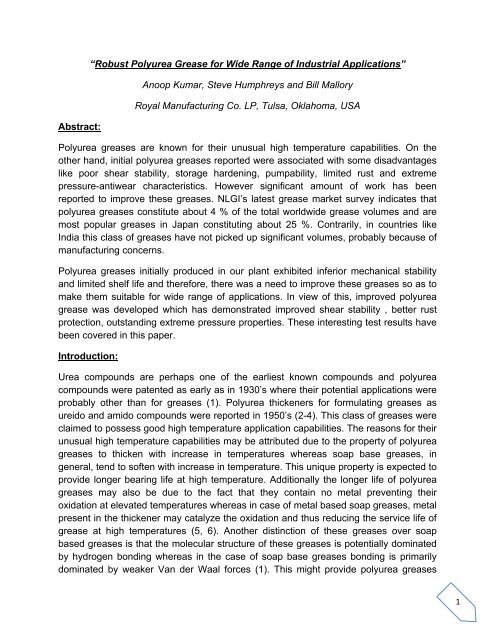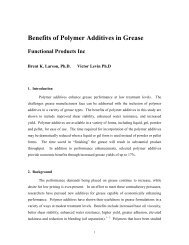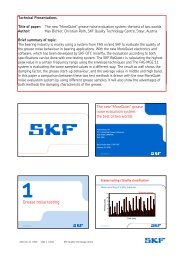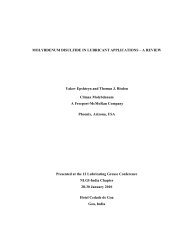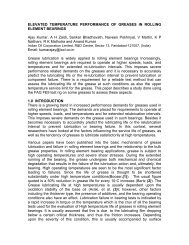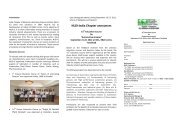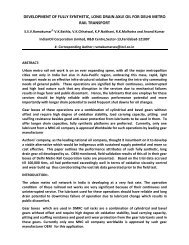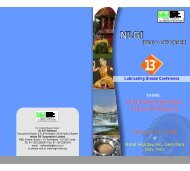âRobust Polyurea Grease for Wide Range of Industrial Applications ...
âRobust Polyurea Grease for Wide Range of Industrial Applications ...
âRobust Polyurea Grease for Wide Range of Industrial Applications ...
You also want an ePaper? Increase the reach of your titles
YUMPU automatically turns print PDFs into web optimized ePapers that Google loves.
Abstract:“Robust <strong>Polyurea</strong> <strong>Grease</strong> <strong>for</strong> <strong>Wide</strong> <strong>Range</strong> <strong>of</strong> <strong>Industrial</strong> <strong>Applications</strong>”Anoop Kumar, Steve Humphreys and Bill MalloryRoyal Manufacturing Co. LP, Tulsa, Oklahoma, USA<strong>Polyurea</strong> greases are known <strong>for</strong> their unusual high temperature capabilities. On theother hand, initial polyurea greases reported were associated with some disadvantageslike poor shear stability, storage hardening, pumpability, limited rust and extremepressure-antiwear characteristics. However significant amount <strong>of</strong> work has beenreported to improve these greases. NLGI’s latest grease market survey indicates thatpolyurea greases constitute about 4 % <strong>of</strong> the total worldwide grease volumes and aremost popular greases in Japan constituting about 25 %. Contrarily, in countries likeIndia this class <strong>of</strong> greases have not picked up significant volumes, probably because <strong>of</strong>manufacturing concerns.<strong>Polyurea</strong> greases initially produced in our plant exhibited inferior mechanical stabilityand limited shelf life and there<strong>for</strong>e, there was a need to improve these greases so as tomake them suitable <strong>for</strong> wide range <strong>of</strong> applications. In view <strong>of</strong> this, improved polyureagrease was developed which has demonstrated improved shear stability , better rustprotection, outstanding extreme pressure properties. These interesting test results havebeen covered in this paper.Introduction:Urea compounds are perhaps one <strong>of</strong> the earliest known compounds and polyureacompounds were patented as early as in 1930’s where their potential applications wereprobably other than <strong>for</strong> greases (1). <strong>Polyurea</strong> thickeners <strong>for</strong> <strong>for</strong>mulating greases asureido and amido compounds were reported in 1950’s (2-4). This class <strong>of</strong> greases wereclaimed to possess good high temperature application capabilities. The reasons <strong>for</strong> theirunusual high temperature capabilities may be attributed due to the property <strong>of</strong> polyureagreases to thicken with increase in temperatures whereas soap base greases, ingeneral, tend to s<strong>of</strong>ten with increase in temperature. This unique property is expected toprovide longer bearing life at high temperature. Additionally the longer life <strong>of</strong> polyureagreases may also be due to the fact that they contain no metal preventing theiroxidation at elevated temperatures whereas in case <strong>of</strong> metal based soap greases, metalpresent in the thickener may catalyze the oxidation and thus reducing the service life <strong>of</strong>grease at high temperatures (5, 6). Another distinction <strong>of</strong> these greases over soapbased greases is that the molecular structure <strong>of</strong> these greases is potentially dominatedby hydrogen bonding whereas in the case <strong>of</strong> soap base greases bonding is primarilydominated by weaker Van der Waal <strong>for</strong>ces (1). This might provide polyurea greases1
etter structural stability at elevated temperatures and a preferred choice <strong>for</strong> fill <strong>for</strong> lifeapplications over metallic based counterparts.Various investigators reported different reactants and different reaction mechanism tosynthesize urea thickeners <strong>for</strong> making greases viz., diureas, triureas, tetraureas andpolyureas. The end use properties <strong>of</strong> resultant polyureas have been reported to beinfluenced to a large extent by the type <strong>of</strong> reactants as well as process parameters (4-5,7-11). On the other hand, early polyurea greases were associated with somedisadvantages like as poor shear stability, storage hardening, poor shelf life, limited rustprotection, limited extreme pressure, anti-wear properties and poor pumpability etc. Aconsiderable amount <strong>of</strong> work has been reported in the recent past to improve theseproperties so as to make them more viable <strong>for</strong> specific end user applications. Withadvancement in <strong>for</strong>mulation technology to make them user friendly , these greases nowfind applications in different industries such as radiation resistant, water resistant,extreme pressure, corrosion resistant , electric contacts and even as food gradegreases etc. ( 12-18). Because <strong>of</strong> wide range <strong>of</strong> applications and significant amount <strong>of</strong>research in this area, the volumes <strong>of</strong> these greases are steadily growing. NLGI’s latestgrease market survey indicates that polyurea greases constitute about 4 % <strong>of</strong> the totalworldwide grease volumes whereas in North America it is about 5.7 %. Interestingly,polyurea greases are most favored in Japan, constituting about 25 % <strong>of</strong> the volume andtheir market share is growing (19).Different polyureas indicate the involvement <strong>of</strong> different chemical compounds and thusinvite a vast array <strong>of</strong> chemical reaction possibilities and ample opportunities <strong>for</strong>synthesizing novel polyurea compounds suitable as thickeners <strong>for</strong> greases with diverseproperties. However, the challenge lies in synthesizing a suitable polyurea thickenerwhere the inherent drawbacks associated with this class <strong>of</strong> greases as mentionedabove can be minimized. In our endeavor to develop multi-purpose polyurea greasesuitable <strong>for</strong> different applications, improved polyurea grease have been developed andevaluated in recent past. This grease exhibits improved shear stability, shelf life, betterrust protection, extraordinary extreme pressure (620 kg weld load and 60 lbs Timken)properties besides retaining its inherent high temperature characteristics. Theseinteresting test results have been covered in this paper. Additionally, shelf life, shearreversibility and compatibility data have also been covered in this paper.Experimental:The grease samples selected <strong>for</strong> these investigations were prepared either in thelaboratory or were commercial plant samples. Samples prepared in the laboratory wereprepared in open kettle and under atmospheric pressure conditions. To avoid manyvariances in these investigations composition and process parameters while preparinggreases both in laboratory and commercial plant remained practically same. <strong>Grease</strong>s2
produced in commercial plant comprise both open kettle and contractor process. Thesamples were tested as per the standard ASTM / IP methods. More relevant detailsabout the grease samples will be covered under results and discussion.Results and Discussion:Characteristics <strong>of</strong> Conventional <strong>Polyurea</strong> <strong>Grease</strong>s:The term conventional polyurea greases referred herein are polyurea greases initiallyproduced by our company. Two types <strong>of</strong> polyurea greases (<strong>Grease</strong> A and <strong>Grease</strong> B),both having different composition and application have been chosen <strong>for</strong> these studies.<strong>Grease</strong> A was basically intended <strong>for</strong> industrial applications and <strong>Grease</strong> B <strong>for</strong> automotiveapplication. Both greases are based on mineral oil and per<strong>for</strong>mance additives wereadded to meet the per<strong>for</strong>mance requirement. <strong>Grease</strong> A is in NLGI 2 consistency and<strong>Grease</strong> B in NLGI 1.5 consistency. These greases, in general, are prepared withcombination <strong>of</strong> substituted aliphatic amines and toluene diisocyanate (TDI);per<strong>for</strong>mance additives were added to match the desired specification. Typical physicchemicaland per<strong>for</strong>mance test data <strong>of</strong> both <strong>Grease</strong> A and <strong>Grease</strong> B are tabulated intable -1. Test data <strong>of</strong> <strong>Grease</strong> A indicate that grease consistency is NLGI 2 and has highdrop point <strong>of</strong> 259 0 C making this grease suitable <strong>for</strong> high temperature applications. Theweld load <strong>of</strong> 400 kg and Timken OK load 50 lbs also indicates that this grease issuitable <strong>for</strong> extreme pressure and heavy duty applications. <strong>Grease</strong> B also exhibitedsimilar characteristics except consistency in NLGI 1.5. Both the greases thusdemonstrated high temperature and extreme pressure capabilities and satisfactoryper<strong>for</strong>mance in the applications. However these greases exhibited inferior mechanical /shear stability (+ 50 unit change in penetration after 10,000 double strokes) and alsopoor shelf life which is the common characteristics <strong>of</strong> polyureas greases but may beconsidered disadvantage in applications where grease need to be pumped like one incase <strong>of</strong> centralized lubrication system.For studying the shelf life <strong>of</strong> this type <strong>of</strong> greases, five retention samples namely <strong>Grease</strong>C, <strong>Grease</strong> D, <strong>Grease</strong> E, <strong>Grease</strong> F, grease G, which were <strong>of</strong> over more than 2 years oldand were produced in commercial plant were taken and tested <strong>for</strong> penetration, droppoint, mechanical stability . The samples more than above stated period were notavailable <strong>for</strong> studies. Test results are tabulated in table - 2 and data indicate thatgreases got hardened up significantly which is evident from the unworked penetrationdata. All the grease samples at the time <strong>of</strong> manufacture were in NLGI 2 (penetration265-295) grade which settled over a period <strong>of</strong> more than 2 years to NLGI 3 (Unworkedpenetration) , however the work penetration data still found to close to s<strong>of</strong>ter side NLGI2 consistency . Drop point <strong>of</strong> all the greases under study was more than 250 0 C whichfound to be well within expected limits. The visual observation <strong>of</strong> samples delineatedthat there was some oil separation from the greases. Additionally, these greases have3
exhibited shear reversibility, settling with time as per penetration and mechanicalstability test (figure-1 and figure 2). The hardening <strong>of</strong> greases as evident from unworkedpenetration and oil separation indicate that grease has poor shelf life and considered anapplication limitation <strong>of</strong> greases particularly in pumpability, in spite <strong>of</strong> the fact that therewere no per<strong>for</strong>mance complaints as such. Additionally manufacturing grease fromtoluene diisocyanate (both 2,4- and 2,6- isomers) is always issue <strong>for</strong> the plant astoluene diisocyanate is considered highly toxic and serious health hazard.Development and Characteristics <strong>of</strong> Improved <strong>Polyurea</strong>s <strong>Grease</strong>s:The ef<strong>for</strong>ts to improve existing polyurea grease technology has been attributed mainlydue to following two reasons• Manufacturing concerns – handling <strong>of</strong> toxic ingredients• Improving shelf life and per<strong>for</strong>manceThere has been growing concern <strong>for</strong> handling toxic raw materials in the plant and aneed was felt to develop improved grease both in terms <strong>of</strong> quality and manufacturingease . In view <strong>of</strong> this, systematic ef<strong>for</strong>ts have been made in our Riverside Laboratory todevelop grease with improved properties. After concerted ef<strong>for</strong>ts improved greasethickener was developed and tailor made <strong>for</strong> different applications both <strong>for</strong> automotiveand industrial applications. The properties <strong>of</strong> two finished greases <strong>Grease</strong> H and<strong>Grease</strong> I are described below. <strong>Grease</strong> H is intended <strong>for</strong> industrial applications and<strong>Grease</strong> I is slated <strong>for</strong> automotive applications including <strong>for</strong> constant velocity joints. Boththe greases were made in mineral oil and VG 220 base oil viscosityThe physcio-chemical per<strong>for</strong>mance test data <strong>of</strong> <strong>Grease</strong> H and <strong>Grease</strong> I are enclosed intable -3. These data are compared with <strong>Grease</strong> A which was grease produced with oldconventional process and materials. Table indicate that grease H and <strong>Grease</strong> I bothexhibited improved high drop points <strong>of</strong> 277 0 C and 275 0 C compared to 259 <strong>of</strong> <strong>Grease</strong>A. Weld load <strong>of</strong> <strong>Grease</strong> A was 400 kg whereas both the greases (<strong>Grease</strong> H and <strong>Grease</strong>I) exhibited 620 kg which is considered very high and sufficient to cover any extremepressure applications. Both <strong>Grease</strong> H and <strong>Grease</strong> I exhibited Timken OK load <strong>of</strong> 60 lbscompared to 50 lbs <strong>for</strong> <strong>Grease</strong> A which is again very high <strong>for</strong> heavy duty applicationsand thus indicating exceptionally high extreme pressure capabilities <strong>of</strong> both greases i.e.,grease H and <strong>Grease</strong> I. Besides this, grease also possesses good water washout outcharacteristics. Additionally this grease also passes rust test tested (ASTM D 1743) andcopper corrosion test, indicating good anti-rust and corrosion resistant properties.Mechanical stability data <strong>of</strong> this grease indicate this grease is comparatively moreshearing stable than previously made greases by us. Mechanical stability tested as perASTM D 217 indicate about 30 unit change in 100,000 strokes which expected to beexcellent <strong>for</strong> polyurea greases compared to 51 unit <strong>for</strong> <strong>Grease</strong> A .Additionally roll4
stability <strong>of</strong> <strong>Grease</strong> H and <strong>Grease</strong> I are 6.4 and 8.4 % respectively compared to 14.5 %<strong>for</strong> <strong>Grease</strong> A and thus indicating that this grease is stable compared to previouslyproduced greases.To further investigate versatility <strong>of</strong> the thickener system two more greases wereprepared with same thickener (<strong>Grease</strong> J and <strong>Grease</strong> K) . <strong>Grease</strong> J was prepared in VG460 base oil and in mineral oils whereas <strong>Grease</strong> K is based on synthetic oil and in VG220 viscosity grade. Test data are tabulated in Table – 4. <strong>Grease</strong> L discussed in table iscommercially available grease based on Synthetic oil and is <strong>for</strong> comparison purposewith <strong>Grease</strong> K. <strong>Grease</strong> J like <strong>Grease</strong> H has exhibited high drop point, high weld loadand Timken OK load and exhibited good mechanical stability close to lithium type <strong>of</strong>greases. <strong>Grease</strong> K when compared with commercially available synthetic polyureagrease exhibited improved mechanical stability and extreme pressure characteristics.However to establish this observation comparison should have been made with moresynthetic oil based polyurea greases and there<strong>for</strong>e this observation might have limitedrelevance.Shear Reversibility:<strong>Polyurea</strong> greases possess inherent shear reversibility which is described by theproperty by which grease s<strong>of</strong>tens with working or under stress and tries to regain itsconsistency when shear <strong>for</strong>ce is removed. The kind <strong>of</strong> shear reversibility behavior isalso exhibited by aluminum complex and titanium complex greases (20). This uniqueproperty may possibly help long service life <strong>of</strong> grease particularly in stop and runconditions. The conventional grease as described above has indicated excellent shearreversibility characteristics (figure 1 and 2). Improved polyurea grease discussed abovehas demonstrated good mechanical and shear stability. This improved mechanical /shear stability may probably result into change in behavior <strong>of</strong> grease especially in shearreversibility characteristics. To study whether this improved polyurea grease as aresultant <strong>of</strong> change in composition has resulted in to similar shear reversibility behavioror else this property is compromised , the shear reversibility <strong>of</strong> these greases were alsostudied ( figure 3 and 4). These figures indicate that these greases are still shearreversible but not to the extent as above mentioned conventional greases.Compatibility with Lithium Complex and Ca-sulfonate <strong>Grease</strong>s<strong>Polyurea</strong> greases are generally considered incompatible with other greases andthere<strong>for</strong>e not very user friendly in some industries. For OEM filled bearing there possiblycould not be any issue but <strong>for</strong> service applications or else refilling, incompatibilitybecomes a concern. Besides this, there are applications like centralized lubricationsystems where completely removing greases already in use or cleaning bearing5
ecomes cumbersome and difficult, incompatibility <strong>of</strong> one grease with other greasescould be a cause <strong>of</strong> serious concern.As polyurea greases are expected to be used where possible change over could beeither lithium complex or sulfonate complex greases, there<strong>for</strong>e these two type <strong>of</strong>greases were studied <strong>for</strong> compatibility with improved polyurea grease. Both theselithium complex and overbased calcium sulfonate complex greases taken <strong>for</strong> thesestudies are greases produced in commercial plant and are <strong>for</strong>tified with per<strong>for</strong>manceadditives. For comparative study blends <strong>of</strong> old conventional polyurea grease were alsomade with lithium complex and calcium sulfonate complex grease. Lithium complex andcalcium sulfonate greases are same as used in case <strong>of</strong> blends with improved polyureagreases. This was done to avoid any other variance in study and also to avoid effect <strong>of</strong>change <strong>of</strong> additives.Compatibility test were conducted on the line with ASTM 6185 test protocol and wastested <strong>for</strong> primarily compatibility tests (drop point, penetration and mechanical stability).The samples were prepared in ratio 90:10, 50:50 and 10:90. However samples weretested <strong>for</strong> drop point by IP-396 instead <strong>of</strong> ASTM D 566 and high temperature storagestability test could not be conducted. Compatibility data <strong>of</strong> conventional polyurea greaseproduced as per old composition with lithium complex and calcium sulfonate grease aretabulated in table-5. The grease was first tested <strong>for</strong> drop point and drop point dataindicate that drop point <strong>of</strong> mixture both (50: 50 and 10:90 mixtures) is less than either <strong>of</strong>the grease alone and similar trend is in case <strong>of</strong> penetration and thus this polyureagrease is incompatible with both lithium complex and calcium sulfonate grease.However more detailed study is needed to comprehend this observation but due to nonavailability<strong>of</strong> old samples this could not be pursued further. On the other hand,compatibility data <strong>of</strong> improved grease with lithium complex and calcium sulfonategrease are tabulated in table-6. The drop point data as presented in table indicate thatthe drop point <strong>of</strong> the mixed greases falls within the drop point <strong>of</strong> two individual greasesor within the repeatability limits <strong>of</strong> test. Interestingly penetration and mechanical stabilitydata also falls within the limits <strong>of</strong> the two individual greases and indicating improved orat least borderline compatibility <strong>of</strong> this improved polyurea grease with lithium complexand calcium sulfonate grease. However, more studies have been planned on moresamples to establish this observation.Conclusions:The polyurea greases are integral part <strong>of</strong> grease lubrication technology and exhibitcertain unique characteristics which probably cannot be supplemented by othergreases. The volume and awareness to use these greases is growing in the industryand subsequently their market share is likely to grow in future. The ef<strong>for</strong>ts made inauthors’ laboratory were to improve polyurea grease technology so as to make it more6
users friendly and also to make it conveniently safe manufacture in plant. The polyureagreases made by us initially demonstrated limitations like storage hardening and limitedshelf life. The improved grease developed has exhibited good mechanical stability,unusually outstanding extreme pressure properties, and good water resistant and antirustproperties. Additionally , preliminary studies conducted on this grease has indicatedits comparatively improved compatibility with lithium complex and calcium sulfonategreases , however more studies are required to establish this interesting observation .Acknowledgements:Authors are thankful to plant personnel <strong>for</strong> arranging the old grease samples and to theRoyal Manufacturing management <strong>for</strong> their permission to present this work.References:1. Nadasdi, T.T. , “ Next generation long-life polyurea greases” Presented at NLGI Annual meeting,20002. Bryant , W.C. et al., “ <strong>Grease</strong> and <strong>Grease</strong> base” US Patent # 2,594,286 , 19523. Bryant , W.C. et al., “ <strong>Grease</strong> and compounds <strong>for</strong> making same and other compounds ” US Patent #2,604,449 , 19524. Swakon, E.A. et al., “Aryl-Urea thickened greases” US Patent 2,710,839, 1955.5. Polishuk AT, “A brief history <strong>of</strong> lubricating greases” 727-752 , Llewellyn & McKane Inc. PA , 19986. Sharma SK et al., “ High temperature lubricants – oils and greases” Journal <strong>of</strong> Tribology International, 16, 4, pp 312-219 , 19837. Kline , JE, Hayne, WL, et al.,“ pre<strong>for</strong>med organic thickeners <strong>for</strong> lubricating greases” NLGI Spokesman, 22,12, 553-536, 19598. Zajac, S J., “Reaction product <strong>of</strong> diisocyanate and alkyl amine salt <strong>of</strong> alkyl phosphoric acid andlubricating oil thickened with same” US Patent 3,002,928, 19619. Birke , A.H., et al., “ Dibenzimidazole-diurea grease thickening agents” US Patent 3,752,765 , 197310. Wulfers , T.F., “ Diurethane-diurea thickened grease compositions” US Patent 3,766,070 , 1973.11. Dreher, J.L., “<strong>Grease</strong> thickened with ureido compound and alkaline earth metal carboxylate” USPatent 3,846,314, 1974.12. Traise , T.P., “ Method <strong>of</strong> lubricating radiation resistant ureido compound thickened with lubricatingoil” US Patent 3,052,633, 196213. Dreher , J.L. et. al., “ <strong>Polyurea</strong>s” US Patent 3,242,210 , 196614. Kawahara, F.K., “ Lubricating <strong>Grease</strong>s” US Patent 3278435 , 196615. Mishima, M., et al., “ Prevention <strong>of</strong> fretting corrosion to wheel bearing by urea grease” NLGISpokesman , 53, 11, 496-504 , 199016. Okamura , S., et al., “ Long life urea grease <strong>for</strong> high temperature and high speed applications” NLGISpokesman , 56, 3, 94-100, 199217. Crocker R.E., “ A polyurea grease <strong>for</strong> food processing industry” NLGI Spokesman, 42, 11, 378-385 ,1979 .18. Endo , T, “ Recent developments in Di-urea greases” , NLGI Spokesman , 57, 1, 199319. NLGI 2008 <strong>Grease</strong> market Survey , www.nlgi.com20. Kumar Anoop et. al., “Titanium complex grease - A product <strong>of</strong> high potentials” NLGI Spokesman, 59,9, 12-18, 19957
Table – 1Test Data <strong>of</strong> Conventional <strong>Polyurea</strong> <strong>Grease</strong>sS. # Property Method <strong>Grease</strong> A <strong>Grease</strong> B1. NLGI grade ASTM D 217 2 1.52. Thickener type - <strong>Polyurea</strong> <strong>Polyurea</strong>3. Color Visual Green Blue4. Base Oil viscositycSt @ 40 0 C ASTM D445 145 145cSt @ 100 0 C14.5 14.55. Drop Point, °C IP 396 259 2576. Worked Penetration, ASTM D 217 286 30525°C7. Change after 10,00051 54strokes8.Four Ball Weld load , kgASTM D 2596 400 4009.Timken OK Load , lbsASTM D 2509 50 50<strong>Grease</strong> Details W / Pen (Filling)<strong>Grease</strong> C ; #36649 ; 04/11/07<strong>Grease</strong> D; #37726 ; 10/15/07<strong>Grease</strong> E ;38051 ; 02/14/07<strong>Grease</strong> F; 38052; 02/15/07<strong>Grease</strong> G;39144, 05/15/07Table – 2Shelf Life <strong>Grease</strong> DataUnworkedPenAs on Nov 09Worked Pen After 10,000StrokesDropPoint , 0C286 229 305 361 258276 230 303 354 257282 195 292 344 254279 227 301 363 261297 235 305 364 2548
Table – 3Test data Improved <strong>Polyurea</strong> <strong>Grease</strong>sS. # Property Method <strong>Grease</strong> A <strong>Grease</strong> H <strong>Grease</strong> I1. NLGI grade ASTM D 217 2 2 1.52. Thickener type - <strong>Polyurea</strong> <strong>Polyurea</strong> <strong>Polyurea</strong>3. Base Oil viscositycSt @ 40 0 C ASTM D 445 145 205 205cSt @ 100 0 C14.5 16.5 16.54. Drop Point, °C IP 396 259 277 2755. Worked ASTM D 217 288 295 303Penetration, 25°C6. 10,000 strokes 51 26 287. 100,000 strokes- 30 328. Roll Stability , % ASTM D 14.5 6.4 8.4change18319. Four Ball Weld ASTM D 400 620 620load , kg259610. Timken OK Load , ASTM D 50 60 60lbs250911. ASTM D5.0 max -Water Washout126412. Copper corrosionIP 112 Pass Pass13. Rust preventivepropertiesASTM D1743PassPassTable – 4<strong>Polyurea</strong> <strong>Grease</strong> in Synthetic Oil and high Viscosity Base OilS. Property Method <strong>Grease</strong> J <strong>Grease</strong> K <strong>Grease</strong> L#1. NLGI grade ASTM D 217 2 1 22. Thickener type - <strong>Polyurea</strong> <strong>Polyurea</strong> <strong>Polyurea</strong>3. Color Visual Green Blue -4. Base Oil viscosityASTM D445cSt @ 40 0 C456 224 1005. Drop Point, °C IP 396 268 270 2759
6. WorkedPenetration, 25°C7. 10,000 strokesASTM D 217288 328 26532 28 458. Four Ball Weld ASTM D 2596 620 620 -load , kg9. Timken OK Load , ASTM D 2509 60 - -lbsTable – 5Compatibility study <strong>of</strong> Conventional <strong>Polyurea</strong> <strong>Grease</strong>Compatibility with Li‐Complex <strong>Grease</strong>Drop Point , 0 C Worked Pen Weld LoadConventional Li‐ complex<strong>Polyurea</strong> <strong>Grease</strong>100 0 261 301 40090 10 228 ‐ ‐50 50 216 324 31510 90 252 302 ‐0 100 263 268 315Compatibility with Ca‐Sulfonate <strong>Grease</strong><strong>Polyurea</strong>Ca‐ Sulfonate100 0 261 301 40090 10 ‐ ‐ ‐50 50 252 310 40010 90 272 302 ‐0 100 316 280 50010
Table – 6Compatibility study <strong>of</strong> Improved <strong>Polyurea</strong> <strong>Grease</strong>Compatibility with Li‐Complex <strong>Grease</strong>Drop Point , 0 C Worked Pen 10,000 Weld LoadPoly Li‐ complexUrea100 0 277 294 323 62090 10 267 288 310 50050 50 260 287 315 50010 90 261 274 312 ‐0 100 263 268 290 315Compatibility with Ca‐Sulfonate <strong>Grease</strong>Poly Ca‐ SulfonateUrea100 0 277 294 323 62090 10 275 292 318 62050 50 273 288 317 50010 90 283 278 305 ‐0 100 316 280 288 50011


